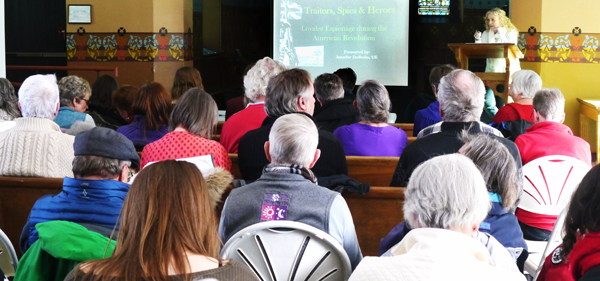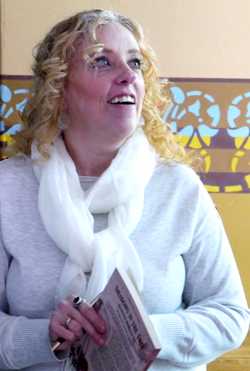Exploring the role of the Loyalist spies
Administrator | Feb 21, 2019 | Comments 0
 Story and photos by Sharon Harrison
Story and photos by Sharon Harrison
Historic Macaulay Church welcomed speaker, author and researcher Jennifer DeBruin Tuesday afternoon as part of the weeklong Flashback February events celebrating the theme, “Spirits of our Past”.

Jennifer DeBruin
DeBruin’s talk covered spies and espionage and the role Loyalists played in the American Revolution. As a United Empire Loyalist herself, with deep ancestral roots in Upper Canada, Quebec and colonial America, DeBruin shared some of her extensive research and findings, providing a glimpse into what she described as a very extensive topic.
“I think it is important to explore the history, in this case the Loyalist spies might be a little more fantastical, but within that there were average people doing extraordinary things,” said DeBruin. “And I think it’s really important to look at people who are swept up in extraordinary experiences and then had to rise to occasions they were ill-prepared for and yet met those.”
The talk and slide-show presentation saw about 50 people engage with the stories DeBruin shared. The information gathered from her research also demonstrated her own personal family history connection to the Loyalist spies and the American Revolution. Several of DeBruin’s cousins, whom she had tracked down during her research, were also in the audience.
“I am certainly excited to be back here in Prince Edward County, a county that was settled by many United Empire Loyalists after the American Revolution,” said DeBruin.
The talk focussed not just on some of the interesting military stories, but how average individuals contributed to the success of the Loyalist spy networks.
“Even though we did not win the war, we did have a very good network of spies with people risking their lives passing along information,” she said.
“It is important to remember that these enemies were once families, friends and neighbours to each other. This idea of civil war adds another element to the devastation that these families were facing.”
DeBruin noted than an agent for secret service appeared as any other individual would, living their usual life but within a hidden secret world of intrigue. Her presentation focused on these very intriguing elements as well as the social history of people, where DeBruin said her tag line is: discoveries, humanity and history.
“I really want to get to know the people who were swept up in the chaos of the American Revolution, and not just on one side or the other, because we do share a common history with our American cousins and they very much are that,” said DeBruin.
For DeBruin, her passion is about discovering the story of people and the lessons she can bring forward into her life.
“History actually lives, it is not something that is just relegated to the past; it can actually connect real people in today’s world and it can actually teach us a lot of lessons.”
DeBruin spoke to the Haldiman papers which she described as an excellent read to get a sense of what was happening during the American Revolution on the British side. The Haldiman papers along with the Upper Canada Land Petition and the Lower Canada Land Petition used in much of DeBruin’s research can be accessed free of charge at Library and Archives Canada.
It wasn’t just soldiers who were acting in the role of the secret service, average citizens were too, including blacksmiths, coopers and farmers among them. And those spies come in the form of both men and women. “Many Loyalists were just ordinary citizens like farmers, swept up and given jobs very foreign to them such as Loyalist spies.”
“It’s important to remember this is not a men’s world necessarily, and while some women were not in a formal role in the secret service, they certainly played an integral role,” said DeBruin.
There were spy networks throughout the colonies in Canada and the United States noted DeBruin. The northern spies’ network operated in New York state and would have had people from Prince Edward County participating.
In her presentation, DeBruin not only used her voice to tell the story of the Smith family (also sometimes spelled Smyth) and their associates, allies and adversaries, but also have her voice speak through time of the individuals who participated where people tell their own story as she quoted direct references from her research materials.
DeBruin went into great detail about the Smith family and the importance they played in the spy network becoming key players. It included Mrs. Smith, her husband Dr. George Smith who was a doctor and a surgeon, their sons Thomas and Terence Smith, Patrick Smith (Dr. George Smith’s brother) and outlined the importance of the secret service in the northern colonies (mostly New York and Vermont) where the Smith family settled in Albany, specifically Saratoga Springs in New York state.
“Because so many individuals could be passing along secret intelligence and information, it’s plausible that if you have Loyalists in your family tree, they were passing along secret intelligence in some way,” said DeBruin. “It could have been a one-time thing or it could have been part of a more structured network.”
“It’s also important to remember, these people were also trying to protect their loved ones as well as trying to win a war.”
The talk also touched on the some of the spy names used. For example, Mrs. Smith’s code name was ‘RI’ (or ‘RJ’), noting that sometimes just initials were used, although in many other cases, unusual or elaborate names were chosen. DeBruin also shed light on counter espionage, double agents, prison exchanges, sabotage and kidnapping.
DeBriun explained how sympathetic ink was used, either with paper impregnated with lemon juice or chemicals, where with the use of heat (usually a candle), hidden text would appear between the lines of a hand-written letter containing information or intelligence, although she noted it was more of a British trick than an American one. Newspapers were very hard to come by, so information crossed enemy lines with frequency through dispatches and other ways too. Paper notes were rolled up tightly and inserted inside the hollow of a quill pen; musket balls and canisters were also used.
“Often they would send out two men with canisters containing the same information and if one was caught by the enemy, the other would often get through,” said DeBruin.
Codes and ciphers were used and could only be deciphered by the handler.
Something as innocuous as laundry hanging on a line could be used to pass along secret intelligence, depending on the items on the line and the order they hung.
“If I put three black garments in a row, one white, then one black that means something to somebody,” she said. “It meant women could participate in a relatively mundane way.”
DeBruin noted the very ingenious methods used mostly because they didn’t want to get caught due to the horrendous prison conditions, which included torture, starvation and even death.
Once the war ended in 1783, the Treaty of Paris was signed and resettlement began as the spy network was disbanded. To reward their loyalty, the former spies were granted land in Canada where new lives were established.
“They were given an axe, one cow between two families, some cloth for the women-folk to make clothes and they would use wood from the forestd with which to build a house and make furniture,” said DeBruin.
She added, “My focus is to remind people that there is a human element to these great wars we’ve all participated in and discovering the history and the humanity is really my focus; the social history of how communities were changed and how people had the fortitude to continue to pick up and move along.”
“I think history has a lot to teach us and we forget that; we can actually still learn lessons from looking back.”
Referring to the opening weekend of Flashback February, Jessica Chase, Assistant Curator, County Museums, described it as incredibly successful with high attendance numbers for all events.
“It’s really awesome to get a ton of people engaged that wouldn’t necessarily be interacting with heritage things,” said Chase who said there was a much broader range of events this year.
The diverse range of events that have taken place so far during Flashback February have included a talk on the Avro Arrow with John Burzynski, an impressive demonstration of the large pipe organ at Picton United Church with organist Murray Baer, insights from the Franklin Expedition, and a paranormal show.
Now in its second year, Prince Edward County’s Flashback February event acknowledges Ontario Heritage Week which runs February 18-24 this year. The third week in February was designated Ontario Heritage Week by the provincial government in 1985.
Flashback February events continue through the week at various locations with County Trivia tonight (Thursday) at the Wellington Legion where you can test your County knowledge, earn bragging rights and win a prize. Making Waves Film Festival at the Regent Theatre Friday showcases Miss Supertest and the Canada C3 icebreaker. A free event at Wellington Library also on Friday celebrates spiritualism with Kinsip Spirits with a tasting and a spirited conversation with Stan McMullin, and the Escape Room at Macaulay House continues Feb 21-23.
Saturday afternoon brings several extraordinary Tyendinaga Mohawk Territory performers to Macaulay Church where they will entertain in a variety of styles from Broadway to folk to traditional. Flashback February wraps up on Saturday, Feb. 23 with a heritage awards dinner at Bloomfield Public House. Click here for full schedule details
Filed Under: Local News
About the Author:































